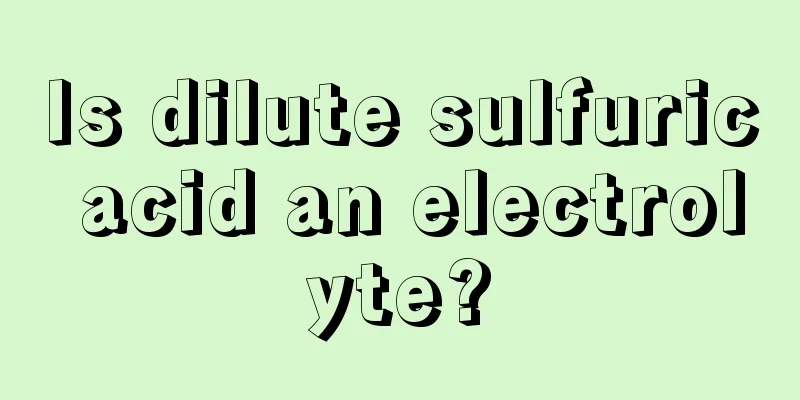Is dilute sulfuric acid an electrolyte?

|
Dilute sulfuric acid is an aqueous solution of sulfuric acid. Since the sulfuric acid molecules in dilute sulfuric acid have been completely ionized, its strong oxidizing properties, water absorption, dehydration and many other properties are very weak. Dilute sulfuric acid is a colorless, odorless and very transparent liquid, but its density is larger than that of water. Many people think that dilute sulfuric acid is an electrolyte. Is this correct? Is dilute sulfuric acid an electrolyte? Let us learn about it together. First, is dilute sulfuric acid an electrolyte? The definition of an electrolyte refers to a compound, and dilute sulfuric acid is a mixture, so dilute sulfuric acid is not an electrolyte, but H2SO4 can conduct electricity in a solution, so H2SO4 is an electrolyte, but its solution is not. The high school textbook definition of an electrolyte is a compound that can conduct electricity in an aqueous solution or molten state. So dilute sulfuric acid is a mixture and is neither an electrolyte nor a non-electrolyte. Second, dilute sulfuric acid can conduct electricity because it is an electrolyte. When sulfuric acid is dissolved in water, it ionizes to produce freely moving ions, so the aqueous solution of sulfuric acid can conduct electricity. Sulfuric acid itself is an electrolyte, and a strong electrolyte. However, dilute sulfuric acid is a mixture, neither an electrolyte nor a non-electrolyte, because electrolytes must be compounds and belong to the category of pure substances. The way of conduction can be the directional movement of ions to produce current, such as the conduction of electrolyte solutions or molten electrolytes, or the directional movement of electrons to produce current, such as the conduction of metals. Third, compounds that cannot conduct electricity in the molten state and in aqueous solution. This concept is relative to electrolytes. Non-electrolytes are compounds that are typically covalently bonded and do not undergo ionization reactions in aqueous solution. Except for carboxylic acids and their salts, phenols, and amines, most organic compounds are non-electrolytes, such as sucrose, glycerol, and ethanol. Among inorganic compounds, only certain non-metal halides and all non-metal oxides (except hydrogen oxide water) are non-electrolytes. Electrolytes include ionic or strongly polar covalent compounds; non-electrolytes include weakly polar or non-polar covalent compounds. Aqueous electrolyte solutions can conduct electricity because electrolytes can dissociate into ions. Whether a substance can be ionized in water is determined by its structure. Therefore, identifying electrolytes and non-electrolytes by their structure is the essence of the problem. In addition, some conductive materials, such as copper and aluminum, are not electrolytes. Because they are not conductive compounds but single substances, they do not meet the definition of electrolytes. Is dilute sulfuric acid an electrolyte? H2SO4 can conduct electricity in a solution, so it is an electrolyte, but dilute sulfuric acid is a solution, a mixture, and the definition of an electrolyte refers to a compound, so dilute sulfuric acid is not an electrolyte. |
<<: Can pregnancy be detected through blood donation
>>: What should I pay attention to when using Gentamycin Sulfate Granules for Children
Recommend
The three main bases for diagnosing skin cancer
If skin cancer is diagnosed in time, it is very h...
How much does biological therapy for ovarian cancer cost
I believe everyone knows that ovarian cancer has ...
The significance of thyroid ect examination
Many people undergo a thyroid ect test during the...
What are the initial manifestations of gastric cancer brain metastasis? These symptoms need attention
After gastric cancer metastasizes to the brain, t...
Is it okay to use pearl powder if I have facial abrasions?
Using pearl powder on facial abrasions is not act...
The dangers of holding urine
Holding urine is a common problem in life. No mat...
What happens if you eat too much ginger candy
Eating too much ginger candy will make us fat, ma...
What are the effects of white giant clam
From ancient times to the present, women who love...
How to prevent testicular cancer
Testicular cancer, also known as testicular tumor...
Will there be a foreign body sensation when the throat is scratched
The throat is related to people's pronunciati...
What's the matter with large areas of acne on the face
I believe that both boys and girls will be very t...
How is melanoma diagnosed
What are the common diagnostic methods for melano...
See what your hair is saying
The human body is a complex whole that can reflec...
Shaanxi Hanzhong Liangpi
In the summer, because the weather is particularl...
What should be paid attention to in routine nursing after lung cancer surgery? 4 things to pay attention to after lung cancer surgery
Lung cancer is a malignant disease. The earlier i...









